Though not directly on the route to Italy or other eighteenth-century ‘Grand Tour’ destinations, Salzburg was nevertheless highly-regarded by contemporaneous travel writers. In 1767, Thomas Nugent wrote that ‘Those who chuse the shortest way [from Nürnberg to Augsburg and Venice] have no occasion to go to Munich or Saltzburg; but such as aim at pleasure and improvement, should by all means see both those cities.’ About the same time, the anonymous New and Complete Collection of Voyages and Travels noted that ‘Saltzburg is a fine city . . . the palace is magnificent, abounding with fine pictures, tables of inlaid marble, and superb stones of all colours, and adorned with statues. . . In the cathedral all the altars are of beautiful marble of different kinds; under the cupola are four altars with an organ, the fifth and finest organ is over the main entrance. . . The roof of this church is covered with copper, the gallery betwixt the cathedral and the palace, is of white marble; and nothing in the world can make finer musick than the chimes of this cathedral.’1
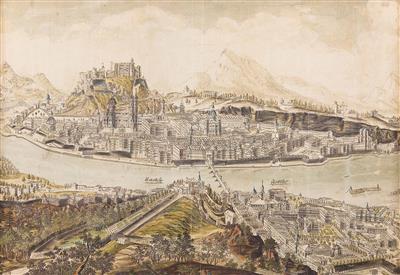
August Franz von Naumann, Hauptansicht der Stadt Salzburg vom Kapuzinerberg, c1790
One of the chief attractions in Salzburg was a mechanical organ, the so-called Hornwerk at the Hohensalzburg fortress. Tourists to the city made a point to hear it, one visitor, in 1798, writing that, ‘In the morning we woke to the most wonderful sounds, floating through the air. . . Three times the sweet melody ended, and three times it began again. It was the organ in the tower across from the Residenz which regularly at seven and eleven in the mornings, and at six in the evenings, played a well-chosen melody. We tried, as often as we cold, to listen in the square.’2 First constructed in 1502, and intended to wake the town inhabitants at four in the morning, the Hornwerk consisted of more than 120 pipes activated by bellows and a wind box. As an open-air instrument, it frequently required repair and in 1753 the Salzburg court organ maker, Rochus Egedacher, was commissioned to renovate and expand the mechanism.3 Egedacher built a new barrel with twelve pieces, one for each month of the year: five of them were composed by the court music director, Ernst Eberlin, and the rest by Leopold Mozart, then a court violinist.
Leopold Mozart published the pieces in 1759 as Der Morgen und der Abend den Innwohnern der Hochfürstl. Residenz-Stadt Salzburg melodisch und harmonisch angekündigt. Oder: Zwölf Musikstücke für das Clavier deren eines täglich in der Vestung Hohensalzburg auf dem sogenannten Hornwerke Morgens und Abends gespielet wird; auf Verlangen vieler Liebhaber, sammt einer kurzen Geschichte von dem Ursprunge der Vestung Hohensalzburg. And the publication was more than just a printed music edition for unlike virtually all editions of instrumental printed music produced in Germany in the eighteenth-century, Leopold’s included a lengthy prefatory text, a potted history of the Salzburg fortress, seemingly a clear sign that the edition was also intended as a memento, as a souvenir of a visit to the city. As such it says something about Leopold as a marketer of his music and, by extension, later, his marketing of Mozart. And it is a sign of Leopold’s intellectual aspirations, which were similarly important for his education of, and expectations for, Wolfgang.
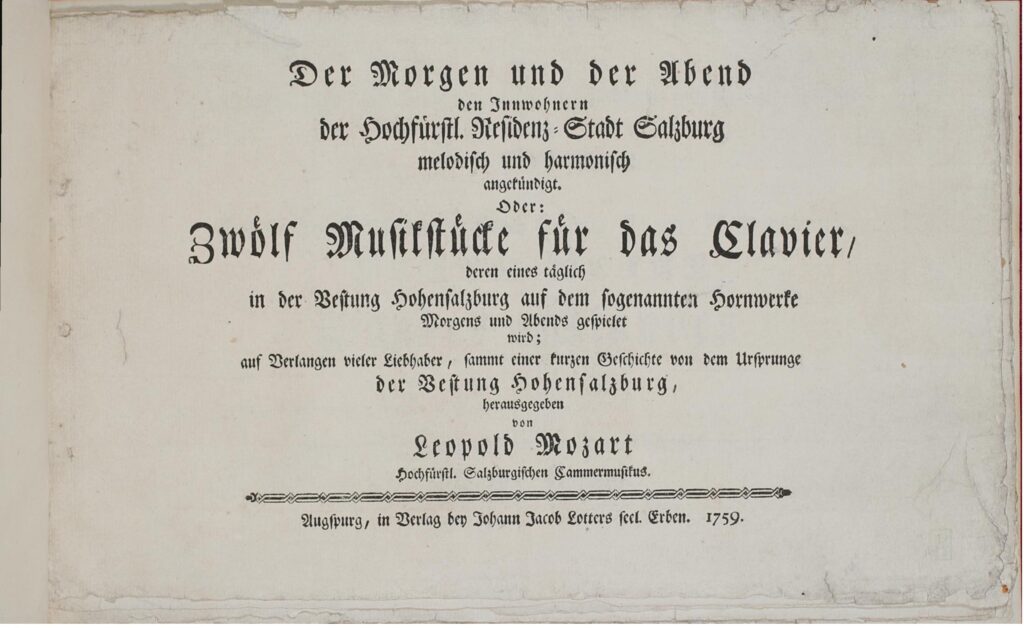
Although on the whole Leopold’s early promotion of Wolfgang was directed to the nobility wherever the family travelled, he also recognized that there was something to be gained from an appeal to a broader public, a public that, especially in cities like Paris and London, paid to attend concerts or purchased printed music. When the family was in Paris in late 1763 and early 1764, Leopold arranged for a family portrait, by the French artist Louis Carrogis de Carmontelle, to be engraved and sold together with Wolfgang’s early printed sonatas. A souvenir of those who had heard or read about the young prodigy, the engraving apparently circulated as late as 1778. Mozart’s motet God is our Refuge K20, presented to the British Museum in early July 1765, is similarly a kind of souvenir. According to a report in the Europaische Zeitung for 6 August 1765, the work was composed at the Museum’s request: ‘The Museum Britannicum asked not only for the sonatas published in Paris [K6-9] as well as those published here [K10-15], together with the portrait of this accomplished family [the Carmontelle engraving], but also for an original manuscript of this Wunderkind, including a short chorus for four voices to English words.’
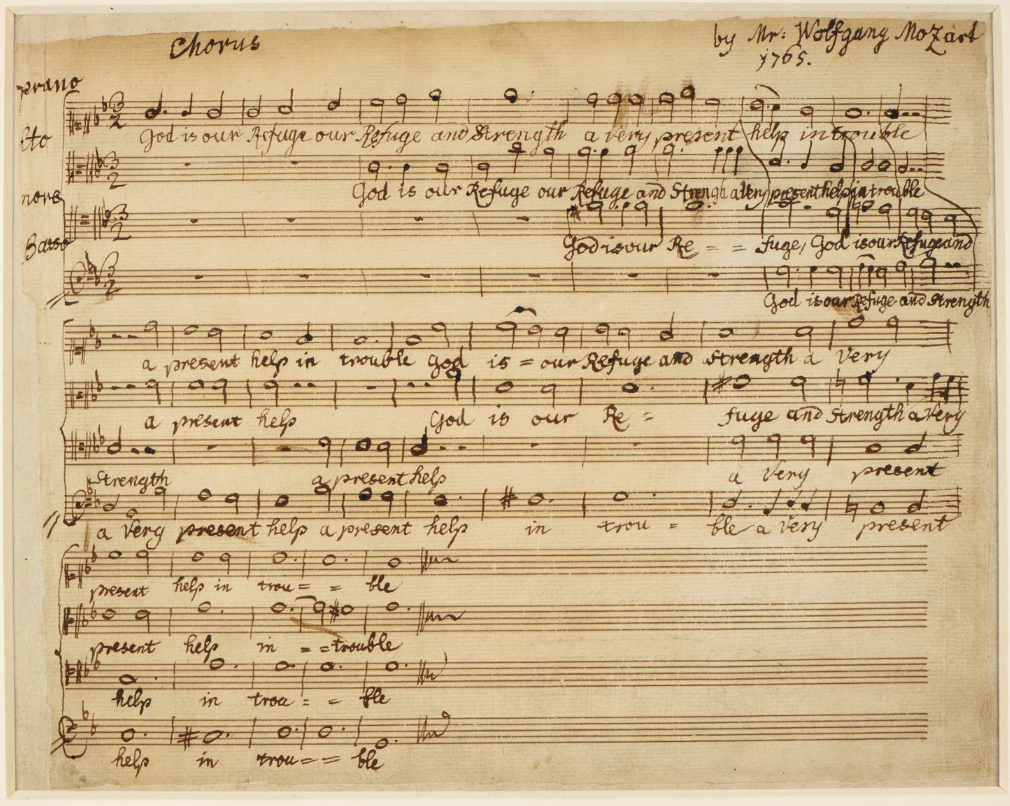
W. A. Mozart, God is our Refuge K20, autograph score (London, British Library)
Leopold’s history of the Salzburg fortress is revealing, too, of his intellectual aspirations: clearly he had done his research, as his reference to Franz Dückher von Hasslau zu Winkl’s Saltzburgische Chronica (Salzburg, 1666), the primary source for Mozart’s account, shows. By the same token, his Versuch einer gründlichen Violinschule (Augsburg, 1756) documents his many musical and philosophical sources, both ancient and modern, including Franchinus Gaffurius’s Theorica musicae (1492); Gregor Reisch’s Margarita philosophica nova (1503); Gioseffo Zarlino’s Le Istitutioni Harmoniche (1558); Michael Praetorius’s Syntagma Musicum (1614-1620); Athanasius Kircher’s Musurgia universalis, sive ars magna consoni et dissoni (1650); Zaccaria Tevo’s Il musico testore (Venice, 1706); and Friedrich Wilhelm Marpurg’s Historisch-kritische Beyträge zur Aufnahme der Musik (1756), among dozens of others. His personal library included works such as Jean Robert Des Pepliers’s Nouvelle et parfaite grammaire royale Françoise et Allemande (Leipzig, 1753; Leopold Mozart’s copy: Salzburg University Library, R 71124 I); Anselm Desing’s Hinlängliche Schul-Geographie vor Junge Leuthe (Salzburg, 1750; A-Su, R 3349 I) and Kürtziste Universal-Historie nach der Geographia Auf der Land-Karte Zu erlernen Von der studirenden Jugend des Bischöfflichen Lycei zu Freysing (Augsburg, 1736; Salzburg, Mozarteum, RaraLit 266); Johann Joseph Fux’s Gradus ad Parnassum (Vienna, 1725; Salzburg, Mozarteum, RaraLit 36); and Giovanni Veneroni’s Il Dittionario Imperiale (Cologne, 1743; Salzburg, Museum Carolino Augusteum, 41555). It is no wonder that as late as 1777, Leopold wrote to Wolfgang, then at Mannheim: ‘I often pointed out to you that – even if you were to remain in Salzburg until a couple of years after you’d turned twenty – you’d lose nothing because in the meantime you’d have a chance to get a taste of other useful sciences, to develop your intellect by reading good books in various languages and to practice foreign tongues.’4
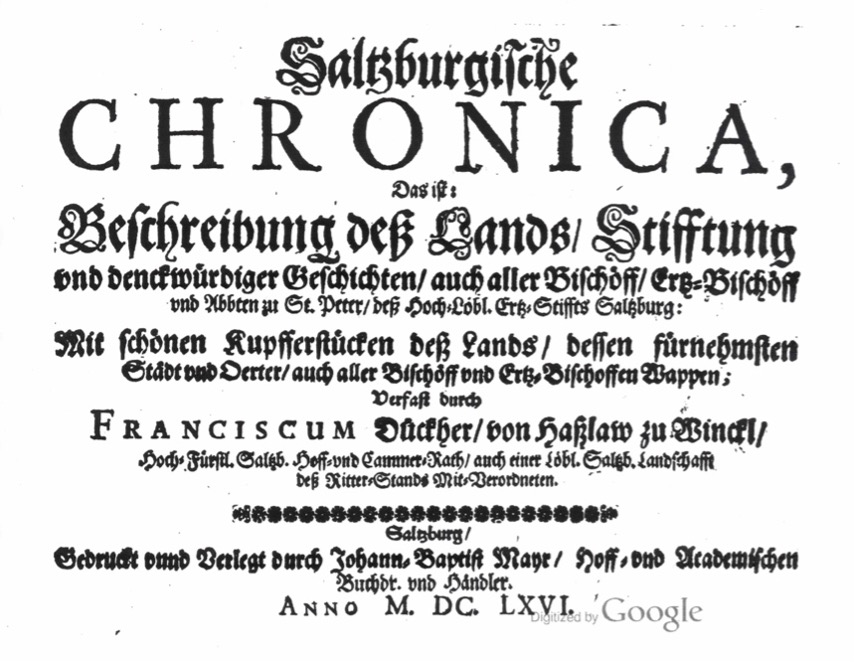
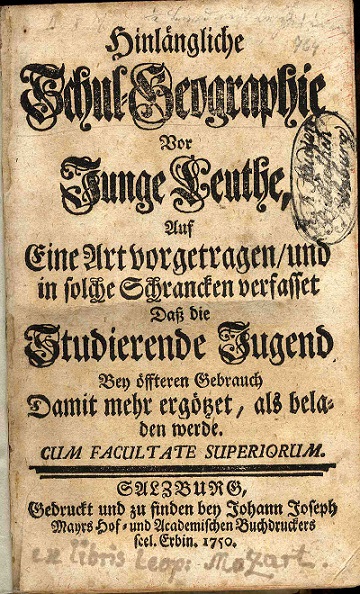
Franz Dückher von Hasslau zu Winkl, Saltzburgische Chronica: Das ist: Beschreibung deß. Lands, Stifftung und denckwürdiger Geschichten, auch aller Bischöff und Abbgten zu St. Peter, deß Hoch-Löbl. Ertz-Stiffts Salzburg (Salzburg, 1666), title page
Anselm Desing’s Hinlängliche Schul-Geographie vor Junge Leuthe (Salzburg, 1750) with ex libris Leopold Mozart (Salzburg, University Library, R 3349 I)
The following translation, by Stewart Spencer, rearranges the format of Leopold Mozart’s original. Mozart’s footnotes, printed at the bottom of the pages, are marked by letters; here they are reproduced in the right-hand column, together with some images not in the original, more or less where they occur in the text, for ease of reading. My footnotes are at end of the document.
Attempt at a Brief History of the Origins of the Fortress at Hohensalzburg
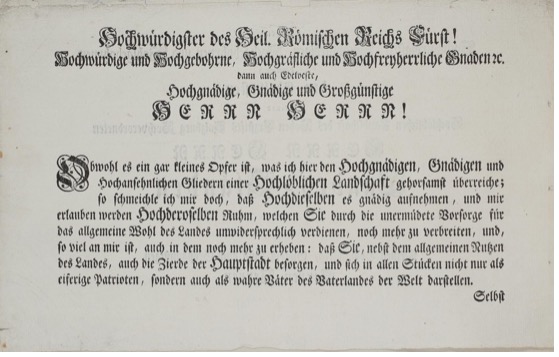
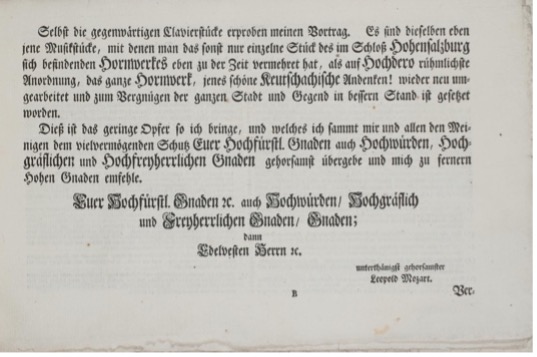
To the Most Worthy, Worthy, Nobly-Born and High-Born and also to the Noble and Designated Lords of the Regional Estates of a Most Praiseworthy Regional Assembly of the High Archbishopric of Salzburg
To my Most Gracious, Gracious and Most Beneficent Lords.
Most Worthy Prince of the Holy Roman Empire!
My Most Worthy and High-Born, Most Lordly and Most Baronial Grace &c.
My Most Gracious, Gracious and Most Beneficent Lords!
Although it is but a small offering that I am presenting most dutifully to the most gracious, gracious and venerable members of a most praiseworthy Regional Assembly, I none the less flatter myself that your lordships will accept it graciously and permit me to add to the reputation that you incontrovertibly deserve through your untiring provisions for the general welfare of this region and, at least to the extent that it is in my power to do so, to raise that reputation to a yet higher level: that you not only contribute to the general benefit of this region but also take care to adorn its main town and in every way present yourselves to the world not only as zealous patriots but also as true fathers of our fatherland.
Even the present clavier pieces put my submission to the test. These are the very same pieces of music as those that have been added to what was otherwise the only piece in the Hornwerk in the Castle of Hohensalzburg at a time when, on your most praiseworthy orders, the entire Hornwerk – that splendid memorial to Archbishop Keutschach – was once again rebuilt and restored to the finest condition to the delight of the town and surrounding area.
This is the small gift that I am offering and which, together with me and all who are dear to me, I am most dutifully entrusting to the all-powerful safekeeping of Your Grace and Most Worthy, Most Lordly, Most Baronial Grace, while commending myself to Your Grace’s subsequent favour.
Your Serene Highness &c and Most Worthy, Most Lordly and Most Baronial Grace and Most Noble Lord &c.
Your most humble and obedient servant
Leopold Mozart.
The Romans would not have invaded Raetia (a) and the Nordgau (b) quite so quickly if they had not – among other fortresses – built a fortress at the egress from the mountains in the Nordgau, which they called Juvavia, presumably from Juva and Via, because it not only served to secure their return route but could also be used as a parade ground From there the lowlands could be overrun at will and subjected to their rule. The emperor Aelius Hadrianus, who ruled from ad 117 to 138, built a town to go with this castle and established a new Roman colony (c) that took its name from him: Colonia Hadriana Juvavia. Over time this town acquired various names, partly as a result of errors on the part of certain writers, but mainly because of the way in which various peoples pronounced it; these names are: Hadriana, Adria, Aderata, Topia, Jopia, Juvavum, Juvania, Joviacum and several more besides. The Germans called it Helfenburg, and the river that flowed past it was called Igonta.5
(a) The borders of old Raetia were Vindelicia, Switzerland and Italy. Vindelicia derives its name from Vindo and Lycus, nowadays the Wertach and Lech, two rivers that run through this region. Hence the phrase: Augusta Vindelicorum.6
(b) The old region of Nordgau or Nordgen included Austria, Styria, Carinthia, Bavaria and the present region of Salzburg as well as a part of Tirol.7
(c) These were the names of the towns where Roman citizens were taken to live and to instruct the old inhabitants in their own way of life.8
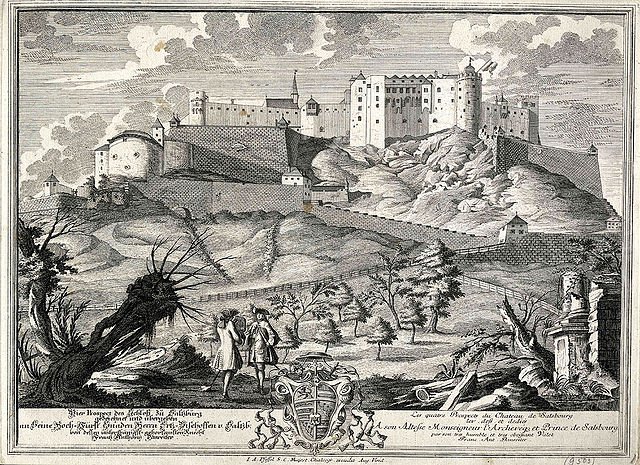
The first to capture this town and cause widespread damage were the Huns (d) when they marched on Italy under their king Attila in 452 (e). And when the Heruli under their king Odoacer made their way from Pomerania to Rome in 476 to drive out Romulus Augustulus (f), Helfenburg suffered considerable damage for a second time when these savage tribes passed through the region. Finally, in the middle of the sixth century, the combined forces of the Sclavini9 and Huns overran the Nordgau and Pannonia (g), driving out the inhabitants of the town of Helfenburg and laying waste to the entire region (h). It was in this sorry state that at the end of the seventh century or at the beginning of the eighth the first Bishop Rudpert – later to be canonized – founded the town when he was invited by Duke Theodo of Bavaria to baptise first himself and then his son and many members of his nobility and to instruct them in the Christian faith and then to cleanse his whole land of paganism, to reintroduce the Christian faith and to establish an episcopal see in a place that would be becoming to it.
d) The origins of the Huns cannot be determined with any certainty. It is most likely that they were Scythians who in their search for a better land attacked other nations and dispossessed them.
(e) Attila cannot have burnt down Helfenburg in 457, as Dückher claims in his chronicle, since four years earlier – in other words, in 453 – he had died on his wedding day or choked on a nosebleed while intoxicated or was even murdered by his new wife. And how could he have spent 3 years laying siege to Aquileia, as some historians report, if in 451 he had fought the united forces of the French king Meroväus [Merovech] at Châlons in Champagne, together with Theodoricus, king of the Goths, King Gorbalus of Burgundy and the Roman governor Aetius, only afterwards going to Italy?10
(f) Romulus Momyllus Augustulus – so called because he was small of stature – ruled for only a year; he was the son of Orestes, a Roman general who drove his own ruler, Julius Nepos, from the imperial house and installed his son in his place. But Julius called on Odoacer to help him and the latter had Orestes killed and imprisoned his son at the castle of Lucullanum. It is worth noting that Rome originated with Romulus but came to an end with this other Romulus since the Western Empire died out with him: just as the monarchy began with the and imprisoned his son at the castle of Lucullanum. It is worth noting that Rome originated with Romulus but came to an end with this other Romulus since the Western Empire died out with him: just as the monarchy began with the first Romulus and ended with this Augustulus.11
(g) Pannonia Inferior was the region that lay between the Danube, Rhaab [Raab] and Draw [Drave] in Hungary, whereas Pannonia Superior is now Crain, Windischmark and Croatia, also a part of Austria.12
(h) Although the actual circumstances and causes of this destruction cannot be determined, it is easy to understand why most countries suffered a good deal at such a time since many savage nations were on the move, leaving behind their own wildernesses in their search for a better place to live.
Once the Romans had been entirely expelled from the Nordgau, the previous names fell into disuse. The river Igonta was now known as the Salzahba13 on account of the nearby salt mines and salt springs because ahb or ack meant water in the dialect of that time; but the town acquired the name of Salzburg. The devastated area was cleared; the buildings were gradually replaced and in particular religion was preached with the greatest zeal; finally a convent was established by Saint Rudpert [Rupert] in the upper part of the former fortress, a convent which, after it had been destroyed by fire was rebuilt by Emperor Heinrich – Saint Henry – on the site where it still stands. It was called Nunberg or, rather, Nonnberg (i).
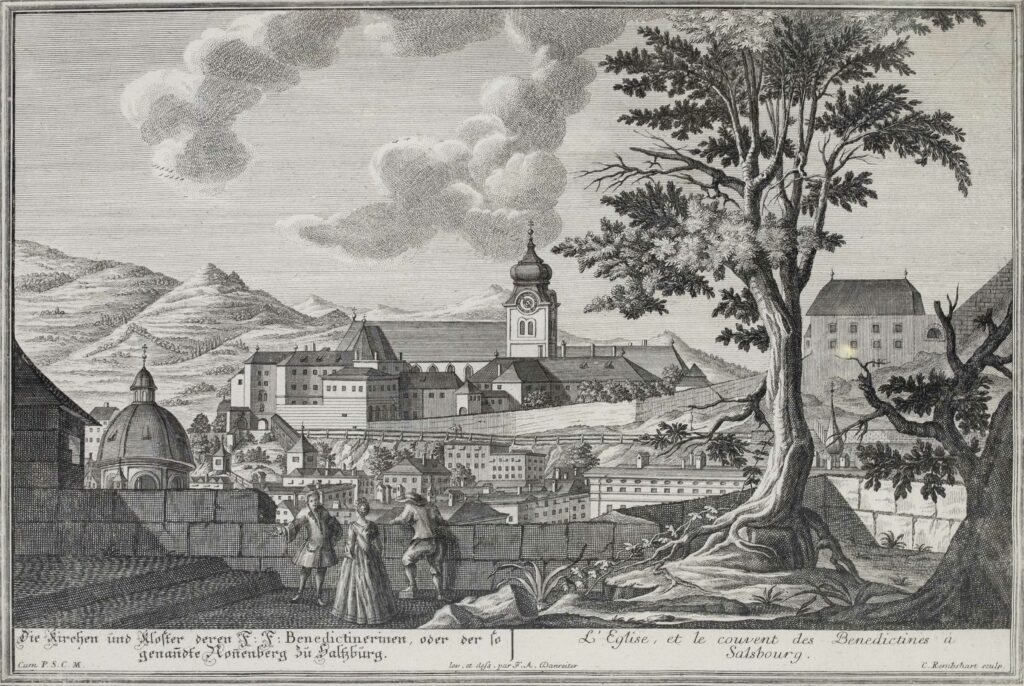
(i) The first convent stood on the site where the homes of the clerics and of the court judge can now be seen.14
Saint Rudpert’s [Rupert’s] successors made a point of adding to the splendours of Salzburg; and it was Archbishop Gebhard of blessed memory, a member of the Helfenstein family, who in the eleventh century completely rebuilt the castle of Hohensalzburg on the summit of the mountain, where it still stands (k). It was much enlarged in the late fifteenth and early sixteenth century by Archbishops Leonhard of Keutschach and Mathäus Lang of Wellenburg (l), who added new fortifications and fitted new wells, which were hewn out of the living rock.
| Finally Archbishop Paris, one of the counts of Lodron, placed the castle in the most perfect state of readiness by acquiring every conceivable kind of military necessity, which he did together with a number of other important and highly laudable actions in the early years of his reign, beginning in 1619; he also fortified the town and the surrounding area as well as all the borders of the archbishopric, which he did at great expense, providing castles and fortified passes and ensuring that it had such a defensive position that not only in 1632, when it was attacked by the Swedes under their king Gustav Adolph but also later, in 1648, when the Swedes again invaded Bavaria under General Wrangel, many high-ranking persons and leaders of the Church sought refuge here with their valuables and the treasures of their Church, while an incredible number of other people fled to Salzburg.15 The fortress and all of its implements of war have been maintained in the most perfect order thanks to the laudable work of the most praiseworthy Regional Assembly just as an Artillery Office Steward has been employed at the fortress right up to the present time at the Regional Assembly’s expense alongside the usual military persons. This steward has an assistant known as the arsenal clerk together with 1 mechanic, 2 compass makers, 9 gunsmiths, 4 armourers, 3 locksmiths, 3 carpenters, 1 blacksmith, 1 cartwright, 1 cooper and 1 mason. |
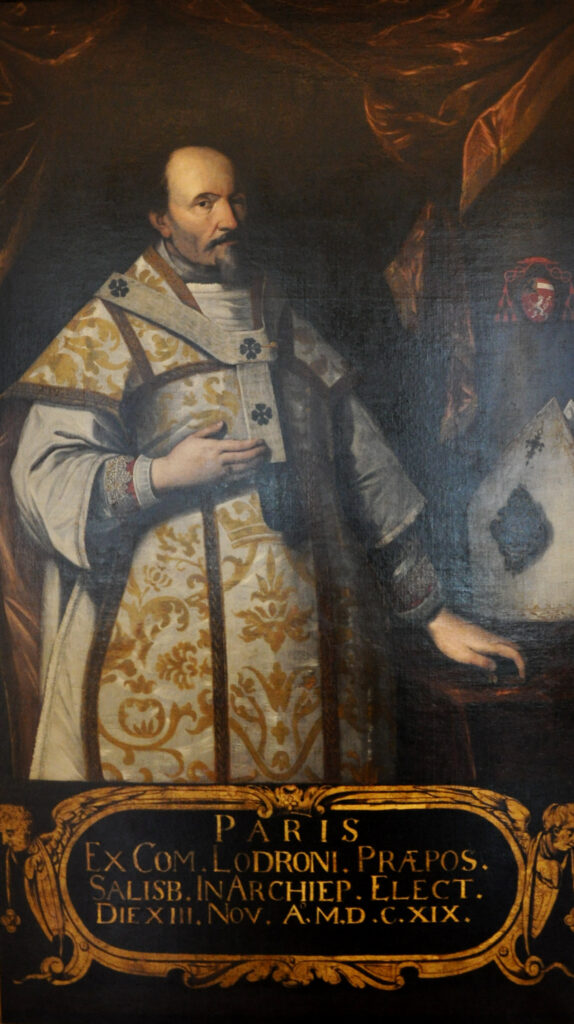
Anonymous, Archbishop Paris Lodron, 1638 (Salzburg, Salzburg Museum)
It would take too long to describe all the unusual items (m) that may be seen here, especially the ancient instruments of war and other remarkable antiquities. So I shall speak only of the Hornwerk (n), which overlooks the town from the very top of the castle and which may be heard each morning and each evening. We owe its existence to Archbishop Leonhard von Keutschach. It is a cylinder and before it plays a piece it emits a so-called ‘scream’ that consists of a perfect chord or harmonic triad (F–A–C) and is a pure mixture comprising Sub-Bass, Principal, Octave, Quint up to Superoctave in 150 pipes, the largest of which is 12 feet, excluding the foot. The instrument that plays these pieces has 200 pipes that increase from the lowest to the highest note and rise, therefore, from 2 to 10, starting with the Principal. The largest of these pipes is 6 feet, excluding the foot; the pipes of the entire Hornwerk are made of tin. From time immemorial it has played only a single piece. By way of a pleasant change the most praiseworthy Regional Assembly has now added 11 more pieces to this and had the Hornwerk, which was quite worn, entirely restored by the court organ builder, Herr Johann Rochus Egedacher (o). Since many amateurs have expressed the wish to have these pieces for the clavier, I have decided to have them printed and instead of a foreword I am including the present attempt at a brief history. But I have no wish to put myself forward here as a historian; and if censorious, envious and troublesome minds cannot conceal their base and highly simplistic way of thinking in the case of this trifle, just as was the case with my Violin Tutor,18 I shall merely laugh! – Why? Petronius answers on my behalf: Quoniam mihi ejusmodi tristes & inficeti homines nunquam inter honestiores cænasse videntur.19
Salzburg 24 February
1759. Mozart.
(m) Among the items that deserve to be listed here is the elaborate draught mechanism known as a ‘Reise’ that allows the heaviest and largest wagons to be drawn up from the Nonnberg to the castle at the cost of much less effort.20
(n) The word Hornwerk is used here in the sense of a set of pipes such as an organ. Strictly speaking a Horn is an artificial word used in organ building and is a mixture in which the major third must stand out and be especially penetrating.
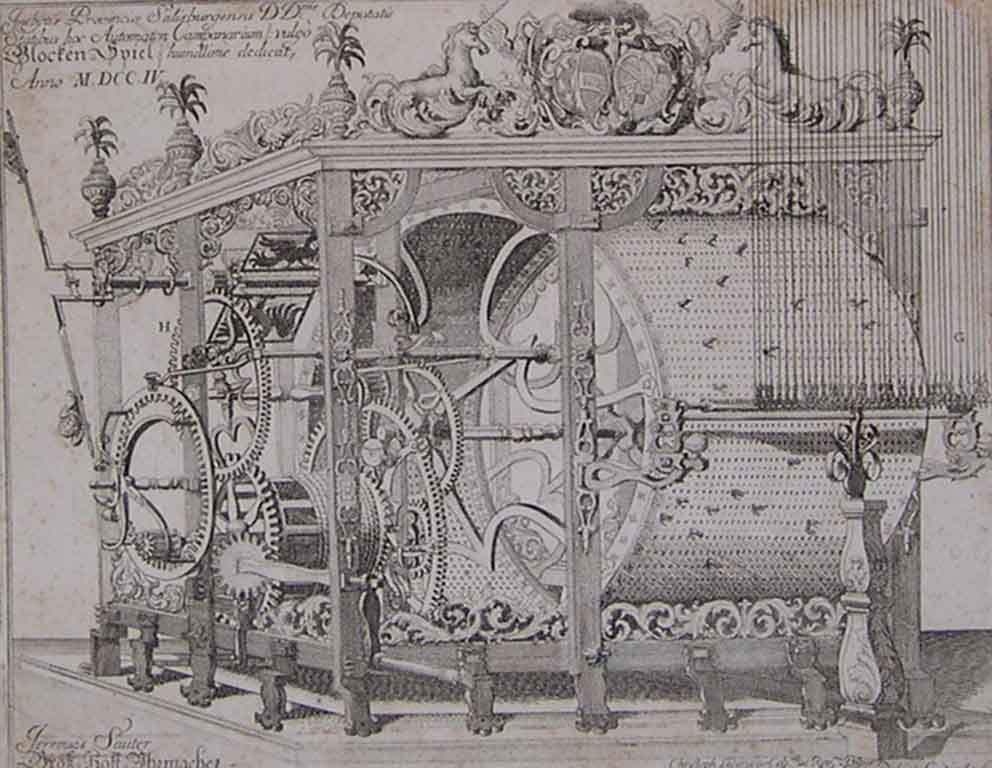
Christoph Lederwasche, Carillon mechanism, 1704 (Salzburg Museum)
(o) This man is the worthy son of his inventive and honest father Johann Christoph Egedacher, the very famous court organ builder in Salzburg, whose other fine works include the large organ in the Cathedral with 3 manuals and 44 stops. His son added a further 4 stops to this instrument a number of years ago.21
FOOTNOTES
1 Thomas Nugent, The Grand Tour; Or, A Journey through the Netherlands, Germany, Italy, and France (third edition: London, 1778), ii.327; A New and Complete Collection of Voyages and Travels; comprising whatever is valuable of this Kind in the most Celebrate English, Dutch, French, Spanish, Italian, German, Swedish, and Danish Writers; Great Part of which has never appeared in the English Language (London, 1760), 436-7.
2 Anonymous, Zeichnungen auf einer Reise von Wien über Trieste nach Venedig und von da zurück durch Tyrol und Salzburg. Im Jahre 1798 (Berlin, 1800), 335.
3 See Gerhard Walterskirchen, ‘Das Hornwerk der Festung Hohensalzburg’ in Hans Bayr, ed., Bericht über die Restaurierung des Hornwerkes “Salzburger Stier”, Salzburg 2002 (Baden-Baden, 2002), 13-24.
4 Letter of 18 December 1777.
5 Ignota was a river god worshipped by the Celtic populations of Noricum, a federation of tribes that included much of modern-day Austria and part of Slovenia.
6 Raetia was a Roman province, established 15 BC; Augusta Vindelicorum is modern-day Augsburg.
7 Leopold’s description of the extent of the Norgau, a medieval margraviate established c1806, appears to be incorrect; essentially it encompassed an area on the northwest frontier of modern-day Bavaria, including present-day Ingolstadt, Mühlhausen and Bürnberg.
8 In fact, the Romans had merged several towns in the area as early as 15BC and granted Juvavium the status of municipium in 45AD. Helfenburg is modern-day Salzburg; the river is the Salzach.
9 The Sclavini were Slavic tribes that invaded and settled the Balkans in the sixth century; there appears to be no evidence they were active in the area around Salzburg.
10 Franz Dückher von Hasslau zu Winkl, Saltzburgische Chronica: Das ist: Beschreibung deß. Lands, Stifftung und denckwürdiger Geschichten, auch aller Bischöff und Abbgten zu St. Peter, deß Hoch-Löbl. Ertz-Stiffts Salzburg (Salzburg, 1666). In fact, Dückher does not claim that Atilla ‘burnt down’ Salzburg, only that he ‘destroyed’ the city. Nor does he give a date for Attila’s attack. As Viktor Töpelmann notes, Leopold also corrects Dückher’s assertion that modern-day Salzburg was founded c582; see Viktor Töpelmann, ‘The Mozart Family and Empfindamkeit. Enlightenment and Sensibility in Salzburg 1750-1790 (dissertation, King’s College London, 2015), 81. Atilla the Hun (c406-453). The circumstances surrounding Attila’s death are unclear: according to Priscus, a fifth-century historian, Attila suffered severe bleeding on the day of his wedding, while Marcellinus Comes, a chronicler active at Constantinople, claims he was stabbed to death by his wife Ildico. The sixth century Roman bureaucrat Jordanes wrote: ‘On the following day [that is, the day after Atilla and Ildico’s wedding], when a great part of the morning was spent, the royal attendants suspected some ill and, after a great uproar, broke down the doors. There they found the death of Attila accomplished by an effusion of blood, without any wound, and the girl with downcast face weeping beneath her veil.’ See John Given, The Fragmentary History of Priscus: Attila, the Huns and the Roman Empire, AD 430–476 (Merchantville, NJ, 2014); The Chronicle of Marcellinus: a translation and commentary, ed. Brian Croke and Theodor Mommsen (Sydney, 1995); Jordanes, The Origin and Deeds of the Goths, trans. and ed. Charles C. Mierow (Princeton, 1908).
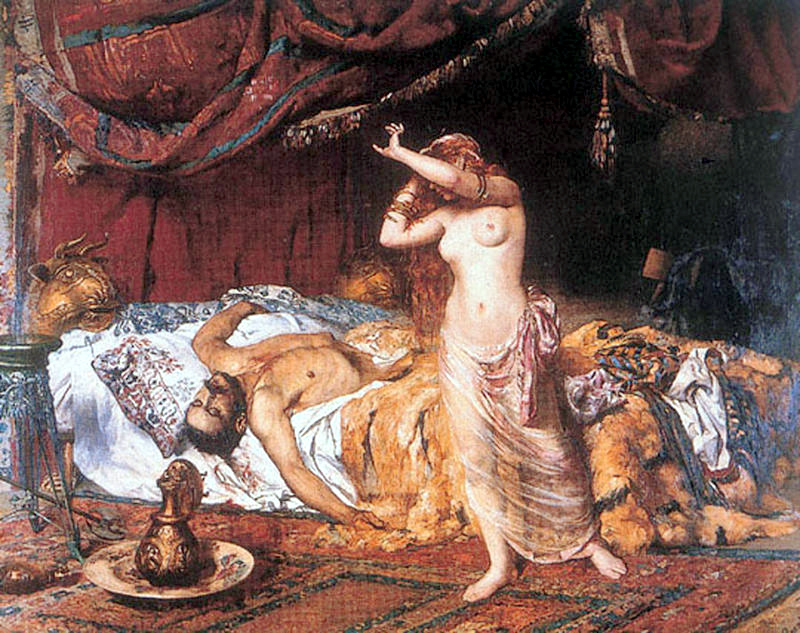
Ference Paczka, The Death of Attila, late nineteenth- or early twentieth-century
Aquilea was established by the Romans c180 BC on the Natsios river, north of the Marano lagoon, about 125 kilmoeters northeast of Venice; at the time, it was one of the largest cities in the world. At the Battle of the Catalaunian Plains (451), a combined army of Romans and Visigoths, under the leadership of Falvius Aëtius (c390-454), defeated Attilla. Merovech (flourished 425-475) was king of the Salian Franks; Theodoric the Great (454-526) was king of the Ostrogoths and ruler of the independent Ostrogothic Kingdom of Italy between 493 and 526. The king of the Burgundians at the time was Gunderic (Gundioc, c420-c473, reigned 437-c473).
11 Romulus Augustus (c465-?after 511), Roman emperor of the west, 31 October 475-4 September 476; Julius Nepos (430-480) was Roman emperor 24 June 474-28 August 475. As Leopold notes, the deposing of Romulus Augustus is taken to mark the end of the Roman Empire. Momyllus (recte Momylus) does not refer to his height but derives from the Greek “little disgrace”; see Edward Gibbon, The History of the Decline and Fall of the Roman Empire. Volume the Third London, 1781), 498. Lucullanum is a fortress in Naples, located on the former island of Megaride.
12 Roman province bounded on north and east by Danube, extending westward to what is today the area around Trieste and south to Dalmatia, including territories now part of Hungary, Slovakia, Austria, Croatia, Serbia, Slovenia and Bosnia and Herzegovina.
13 Now the Salzach.
14 Rupert of Salzburg (c660-710 or 1716/18) was bishop of Salzburg from 696 and abbot of St Peter’s Salzburg. Rupert laid the foundations of Salzburg Cathedral in the early eighth century and founded Benedictine nunnery Nonnberg 711-712. Henry II (6 May 973-13 July 1024), also known as Saint Henry the Exuberant, was Holy Roman Emperor 14 February 1014-13 July 1024. Nonnberg had been destroyed by fire c1006.
15 Lodron’s fortifications included five bastions on the north side of the Salzach and a levelling of the rocks of the Mönchsberg, which served as natural defensive walls, as well as an expansion of the fortress. The Swedes, under their commander Carl Gustaf Wrangel (23 December 1613-July 1676), attacked Salzburg twice during the Thirty Years’ War.
16 Gebhard von Helfenstein of Salzburg (c1010-15 June 1088) was archbishop from 30 July 1060; rebuilding of the fortress began in 1077.
17 Leonhard von Keutschach (c1442-8 June 1519) was prince-archbishop of Salzburg from 1495. Matthäus Lang von Wellenburg (1469-30 March 1540) was prince-archbishop from 1519.
18 Leopold Mozart, Versuch einer gründlichen Violinschule (Augsburg, 1756)
19 ‘It seems to me that such sad and infected men never dined among the more honorable.’
20 The Reise or Reisszug is a cable railway that runs from Nonnberg to the central courtyard of the fortress, passing through five concentric defensive walls, each of which has a gateway with a wooden door. It was constructed during the reign of Leonhard von Keutschach.
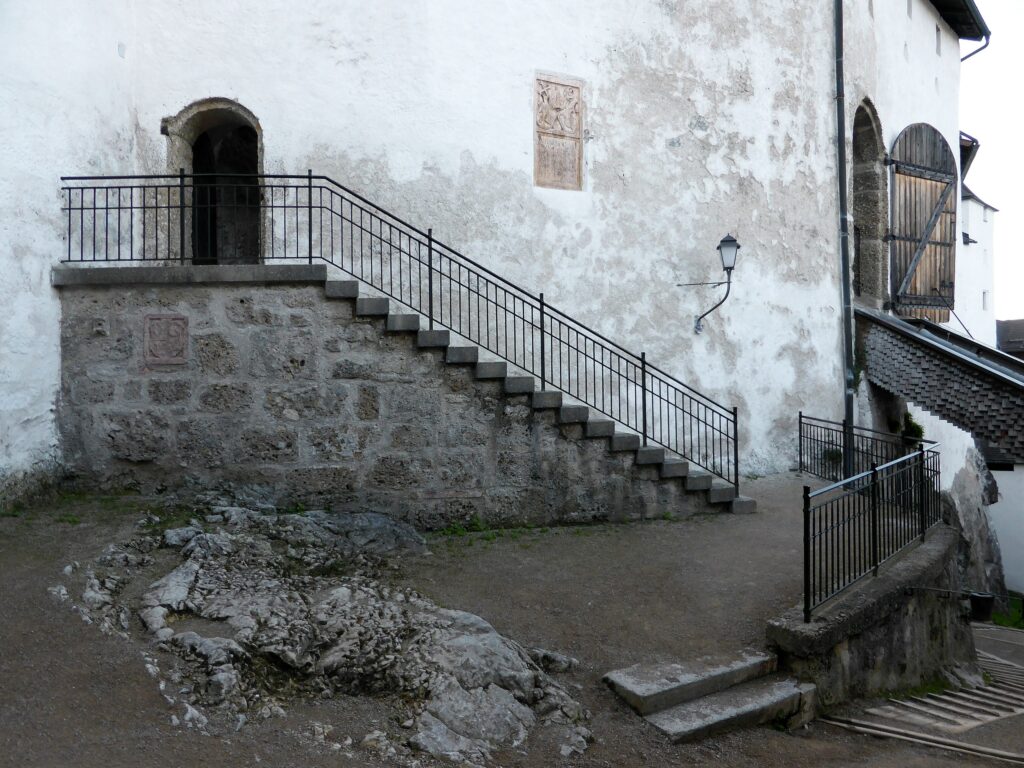
© 1971markus@wikipedia.de, CC BY-SA 4.0, https://commons.wikimedia.org/w/index.php?curid=55184535
21 Johann Christoph Egedacher (3 January 1666-13 September 1747), court organ builder (Hoforgelmacher) 1706-1747; Johann Rochus Egedacher (5 August 1714-14 June 1785), court organ builder 1747-1785. The carillon was most recently renovated 2009-2010; see https://www.salzburgmuseum.at/en/locations/the-salzburg-carillon/: ‘The great brass cylinder with its 7,970 holes can play more than a hundred different music pieces. Sixteen compositions are from the time before 1799. Formerly, these were attributed to Johann Michael Haydn. The pieces by Mozart, father and son, are arrangements from the nineteenth century. Many well-known melodies are included in the repertoire: “Das klinget so herrlich” from Mozart’s opera “The Magic Flute”, also “Là ci darem la mano” from Don Giovanni; folk songs such as “In einem kühlen Grunde”, “Komm lieber Mai und mache”, “Ännchen von Tharau”, “Loreley”, the “Planing Song” from Ferdinand Raimund’s “The Spendthrift”, a minuet by Leopold Mozart, and the famous Salzburg carol “Silent Night”. Not only these, but also lovely pieces from more recent times have been played, such as “Récit évangélique” by Olivier Messiaen (1908-1992).’


